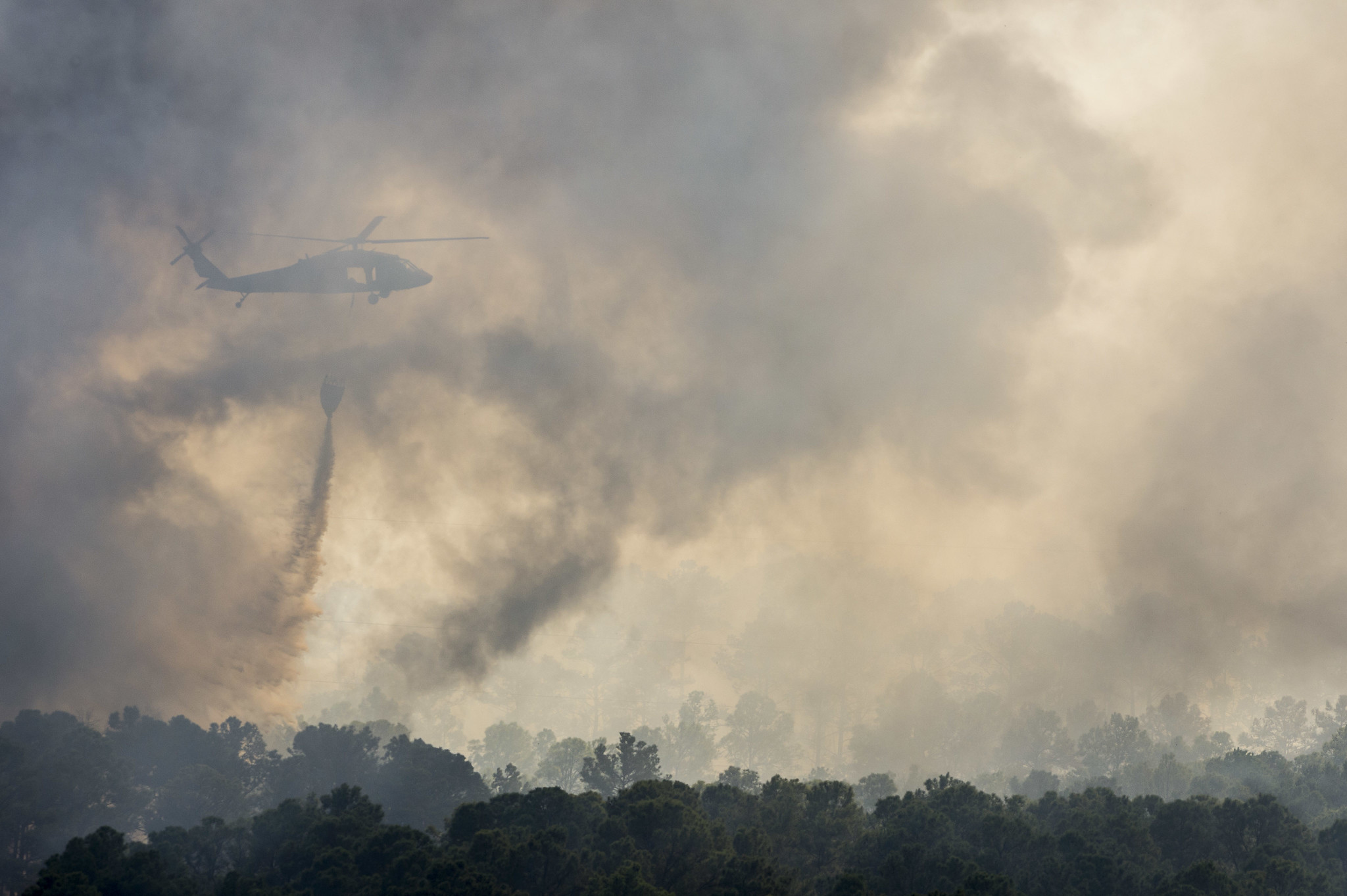Jody Forbus first volunteered for his local fire department in 2007, the year after his own house in the small Eastland County town of Carbon burned down in a sweeping wildfire.
He was mainly determined not to lose his own home again, but soon took a broader view.
“I don’t want anybody to have to go through that,” he said.
In 2009, Forbus became Carbon’s fire chief and has served in the role ever since.
Across large swaths of Texas, wildfires are an inevitability. The state’s wildfire risk, the second-highest in the country after California, is expected to rise further as the climate changes, according to a 2021 report from the state climatologist’s office at Texas A&M University. Some experts and first responders say Texas is already seeing more frequent and more destructive wildfires—a trend influenced not just by climate change but also by population growth. While the state has the resources it needs to respond to wildfires today, without continued investment, that could change.
This year, Forbus and his neighbors grappled with yet more destruction. The Eastland Complex fires in March were the worst in the state since 2011. They destroyed 86 homes in Carbon—approximately 75 percent of the town—and dozens of buildings across neighboring communities. One person, Eastland County Sheriff’s Deputy Barbara Fenley, died while trying to check on an elderly resident of nearby Gorman.
“It’s what they call a perfect storm,” Forbus said.
The same day the Eastland fires broke out, the Texas A&M Forest Service responded to 38 others, according to an agency spokesperson. By the end of that week, local, state, and federal firefighters had responded to 178 wildfires across the state.
“It has been one of the more active fire seasons so far in recent memory in Texas,” said State Climatologist and Atmospheric Science Professor John Nielsen-Gammon.
Carbon, a two-hour drive west of Dallas, is home to just 272 people, according to the 2020 Census. The town was founded in the 1880s and named for the area’s mineral deposits (three of its main streets are called Coke, Diamond, and Anthracite). The all-volunteer fire department has 20 firefighters—a significant chunk of the town’s adult population, but a small team compared to career fire departments in bigger cities.
Even if Carbon had all the firefighting resources it wanted when the fires broke out on March 17, such a large wildfire would have still caused significant damage, Forbus explained: “On days like that, there’s really no one thing that we could have done differently.”
Over the last decade, far-flung areas of Texas have suffered losses from fire similar to Carbon’s. Before the Eastland fires, the disastrous 2011 fires in Bastrop County near Austin killed two people, destroyed more than 1,600 homes, and caused an estimated $325 million in insured property damages, according to the Insurance Council of Texas. The Bastrop fires burned through much of the Lost Pines, a unique ecosystem of loblolly pine trees that has adapted to a dry climate and grow farther west than any other loblollies in the country. A few years later, in 2015, Bastrop Country suffered from another large wildfire.
In 2017, an outbreak across the Great Plains burned 480,000 acres in the Texas Panhandle and killed five people, including two young cowboys and a nurse who managed to save a ranch’s cattle but lost their own lives in the process. Many other ranches in the area lost either their livestock or the grass they depended on.
Wildfires break out when several factors come together, including strong winds, hot and dry weather, and an abundance of vegetation on the ground that could turn into fuel. Climate change is leading to longer stretches of drought in Texas, meaning conditions are becoming more and more favorable for wildfires. In already-dry West Texas, rainfall limits the amount of grass and brush that grows each year. This relative lack of vegetation means wildfire risk has risen more slowly on the prairie. But, as the rest of the state dries out, more wildfires may continue to break out in the forests of East Texas, according to a 2021 report from the state climatologist’s office.
“Most of the state is going to have wildfire fuel to burn,” Nielsen-Gammon said. “The hotter, drier conditions will lead to greater fire risk.”
The existence of wildfires isn’t all bad. For millennia, the region’s plants and animals evolved alongside regularly occurring wildfires and fires set by the region’s Indigenous peoples. Today, the Alabama-Coushatta Tribe of Texas uses prescribed burns to clear brush on the forest floor and protect longleaf pine trees, which depend on fire to grow.
What can make wildfires so destructive, though, is the growing human population of Texas and the growing number of homes on the edges of population centers. In a zone that experts call the “wildland-urban interface,” homes and communities surrounded by vegetation are especially at risk.
“Wildfire in Texas does seem to be a growing problem. We see more and more wildfires, it seems like, every year,” said Wes Moorehead, fire chief at the Texas A&M Forest Service, the state agency that helps local fire departments deal with wildfires.
Prescribed burns done under carefully controlled weather conditions can also help reduce the risk of larger, catastrophic wildfires by clearing away excess brush. But more than 90 percent of all land in Texas is privately owned, giving the lion’s share of responsibility for wildfire prevention to individual landowners. While the state can respond to wildfires, there’s only so much it can do to prevent fires in the first place. Experts emphasized that ultimately, it’s up to private citizens to protect their homes and communities by maintaining their land and hardening their homes.
“What I see going forward is Texans helping protect themselves against the next wildfire,” Moorehead said.
In smaller communities like Carbon, local fire departments, which are usually the first to respond to wildfires, are also preparing for the future as best they can. The state has more than 1,800 fire departments total, of which more than 1,300 are entirely volunteer-run. Training and equipping these small, local departments is a top priority for the Texas A&M Forest Service, according to Moorehead.
Still, the volunteer firefighters in a small town can’t contain a large wildfire on their own.
“There’s just no way,” said Forbus. “You need air support. You need hundreds of firefighters.”
Normally, the Texas fire-response system works well, Moorehead said. Nine out of 10 times, local fire departments contain wildfires in their areas without any outside assistance. For the few times when locals can’t contain a fire, the Forest Service is on hand. The agency relies on its predictive services department to pinpoint high-risk areas, issue warnings ahead of time, and position state firefighters and equipment in those areas. All local fire departments are also part of the Texas Intrastate Fire Mutual Aid System, through which they travel to help each other out. And when even the state’s resources aren’t enough, Texas can call in specialized wildland firefighters from other parts of the country.
The Eastland fires, however, happened at an exceptionally busy time. On the first day, when Forbus heard his pager go off, the Carbon fire department was actually away helping battle a separate fire in neighboring Brown County. Every single local fire department around Carbon was busy on different fires, leaving Forbus’ team no choice but to defend their town on their own. Reinforcements from the Forest Service and out of state arrived on the second day. But by that point, the fire had already swept through town.
“We know help is coming,” Forbus said. “It’s just—the damage is done. Unfortunately.”
Carbon’s emergency went from bad to worse when the wildfire burned down utility poles in addition to people’s homes. Water pumps that run on electricity went out of commission, and the fire department ran out of water. Firefighters resorted to trucking in water from 10 miles away, which wasted precious time.
The causes of the Eastland fires are still under investigation, but a common instigator of wildfires in the area is downed power lines. That was what caused the 2006 fire that burned Forbus’ home, as well as the Bastrop fires in 2011. Forbus urged state officials to figure out how to prevent such fires, and utility companies to trim trees around their power lines.
“Somebody needs to be held responsible, in our mind,” he said.
In the meantime, his town is focused on recovery. According to city officials, that will be hard, as more than half the people who lost their houses didn’t have home insurance. Because Carbon is such a small community, with modest houses, residents’ losses didn’t add up to the $47 million threshold for assistance from the Federal Emergency Management Agency, either. Some state aid might come along later, but for now, the town’s residents are relying on the Red Cross and on donations from individuals, churches, and businesses.
Some people still have piles of rubble to clean up. Others are scrambling to find storage units for donated supplies. A few have progressed to pouring the foundations for new houses.
In addition to his role as fire chief, Forbus is the pastor of the Carbon Community Baptist Church. Losing his home years ago prepared him and his wife Wendy to minister to the firefighters and members of their congregation who lost houses this time around, he said. Their church is still standing, and despite the hardships of the past several weeks, they had an Easter egg hunt and services planned as usual for the holiday weekend.
“We’re seeing a little bit of life come back,” he said.




